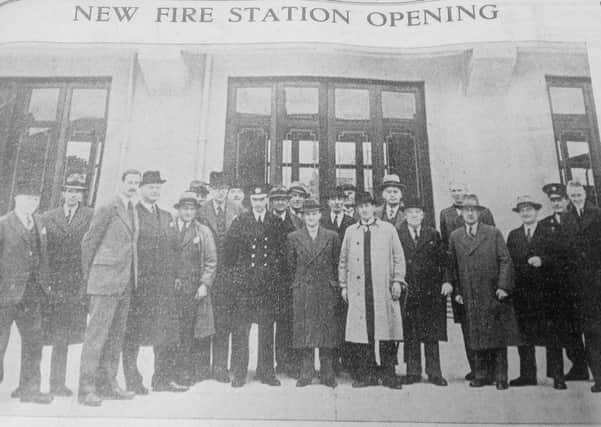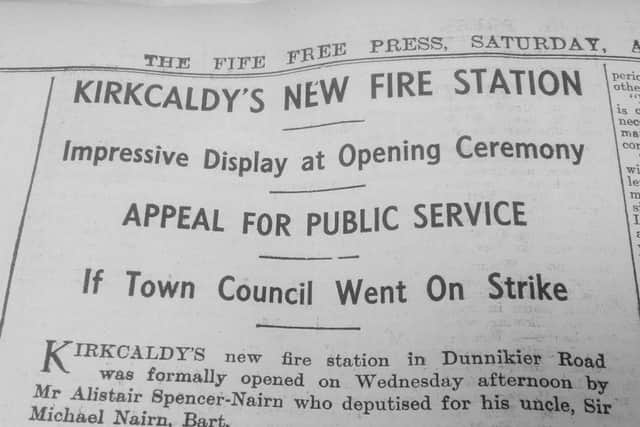1938: Doors open to Kirkcaldy's new fire station


he doors to the ice rink opened, M&S moved into town, and Kirkcaldy fire station also made its debut.
It was a significant development for the town which, effectively, delivered its first ‘proper’ fire station.
Advertisement
Hide AdAdvertisement
Hide AdThe emergency service had been based in Cowan Street where access to roads was poor, and the main engine was originally horse-drawn.


Staff were all auxiliaries – even the firemaster worked in Leven.
A proposal to buy a motorised vehicle at the ratepayers’ expense was hotly debated before common sense won out, and two firemen were also appointed, effectively laying the foundations of the service we know today.
The Town Council’s search for a new site led it to Dunnikier Road, and a £15,000 building quickly took shape.
Advertisement
Hide AdAdvertisement
Hide AdWhile house fires were few and far between in 1938, the brigade did have a frontline role when it came to workplaces and municipal buildings, and the new headquarters were still on the planning table when two major fires broke out at the start of the year.
January witnessed the biggest fire in a decade when the boiler house and classrooms at the old Viewforth High School, Loughborough Road, went up in flames.
Two joiners and caretakers were trapped, and had a narrow escape as the roof caved in and the fire spread. Local residents were ordered to the roof of their adjoining flats to avoid falling debris.
And then, one week later, an even more dramatic fire engulfed the former St Mary’s malt barns belonging to Messrs R. Hutchison & Co, of East Bridge Mills.
Advertisement
Hide AdAdvertisement
Hide AdThe Fife Free Press reported that some 5000 people turned out to watch the drama, and the flames could be seen for miles around.
Firemaster Christie summoned the full resources of the fire brigade – the harbour was less than 50 yards away and two fire engines were engaged for over eight hours pumping water from the dock on to the flames.
Within 20 minutes, the maltings and a store were a crackling mass of flames. At one period, an electricity transformer situated near the burning building appeared in grave danger and some fears were entertained that an explosion might take place. Firemen wore rubber gloves to prevent them from receiving shocks.
A number of railway waggons, caught in the heart of the blaze, were destroyed.
Advertisement
Hide AdAdvertisement
Hide AdAbout 300 tons of oats, wheat and barley were lost and the building itself was a total wreck; all that remained were blackened walls and twisted steel girders. The wheat store in the bins in the adjacent Tollhouse Maltings was also badly damaged – and estimates put the total bill at £20,000 to £25,000.
The only casualty was Police Inspector James Smith who sustained an ankle inujury when he fell between two waggons while controlling the crowds, but refused to go off duty until his services were no long required.
Against that backdrop, the new fire station was formally opened by Mr Alistair Spencer-Nairn, deputising for his uncle, Sir Michael Nairn.
There was a large attendance at the ceremony after which the firemaster have a comprehensive display of firefighting methods.
Advertisement
Hide AdAdvertisement
Hide AdAn electric bell sounded loudly and unceasingly to signal the start of the demonstration. There was a clatter of feet along the balconies as the firemen raced along, adjusting their helmets and axes as they went.
They slid down the pole to the waiting engine, there was a whirr of the motor, the doors swung open and the engine with its sirens sounding, dashed out. Time, exactly, 20 seconds.
Methods of firefighting were demonstrated behind the station – nozzles, extinguishers, and a Pouderoux Variable nozzle which the jet can vary from three-eighths of an inch to up to one inch without the firemen having to run back to the hydrant,
A hut was set on fire, large pans of oil extinguished, and one of the brigade jumped from the two-storey window into a sheet held by colleagues.
Mr Spencer Nairn hailed the crew as “a distinguished body of men who did not always get the merit they deserved.”
